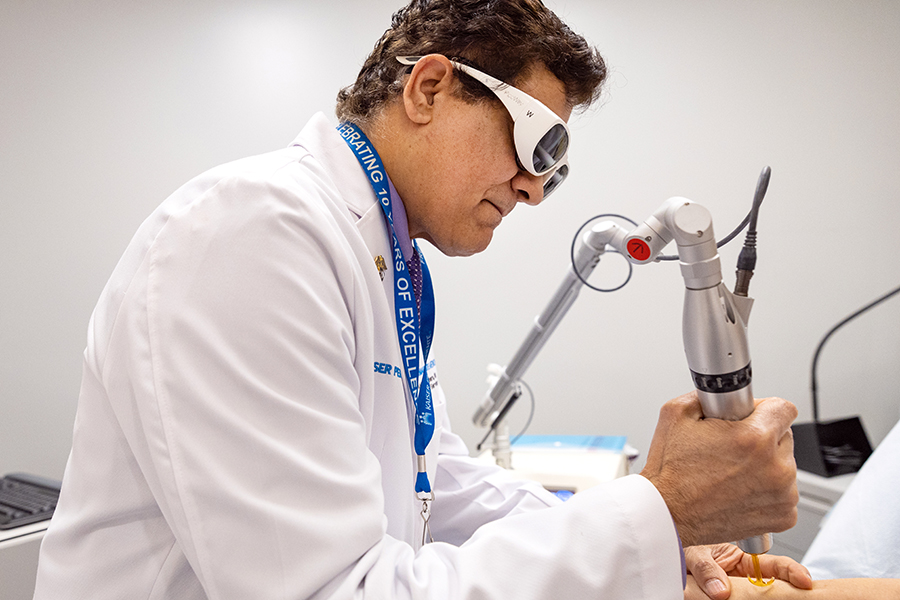April 29, 2022
Advance Alert Monitor began with an algorithm developed at the Division of Research
Kaiser Permanente Northern California’s life-saving Advance Alert Monitor (AAM) program — an early detection system that helps care teams predict when hospitalized patients are at risk for clinical deterioration — has been recognized by The Joint Commission and National Quality Forum.
The program was honored with the 2021 John M. Eisenberg Award for Local Level Innovation in Patient Safety and Quality. The prestigious national award recognizes those initiatives that improve patient safety and overall quality of care.

Richard Isaacs, MD, CEO and executive director, The Permanente Medical Group.
AAM uses a predictive algorithm developed by physician researchers at the Kaiser Permanente Division of Research that scans almost 100 elements from patient health records hourly at 21 hospitals in Northern California, giving clinicians a 12-hour lead time prior to clinical deterioration, permitting early detection and intervention.
“Advance Alert Monitor is another example of how our physicians and staff maximize our extensive clinical and operational expertise, our technologically advanced systems, and our integrated care delivery model to provide exceptional care to our patients,” says Richard Isaacs, MD, FACS, CEO and executive director of The Permanente Medical Group. “By combining the groundbreaking use of predictive analytics with clinical workflows, we’ve created a Northern California virtual center that is saving lives by helping us identify patients in medical-surgical and transitional care units who may need expedited care.”
The output of the algorithm is monitored remotely by clinical staff who virtually observe all Kaiser Permanente Northern California hospitals, and who immediately contact the patient’s local care team in the event of an alert, enabling physicians and nurses to provide critical and potentially life-saving treatment more quickly.
A recent analysis of the program by the physician researchers who developed it, published in the New England Journal of Medicine, found the system was responsible for preventing on average 520 deaths per year over a 3-and-a-half-year study period. It also showed a lower incidence of ICU admissions and shorter hospital stays.
“This award is a testament to the ongoing work of Kaiser Permanente Northern California to provide our clinical care teams cutting-edge technology that enables them to predict and prevent serious complications before they happen,” said Carrie Owen Plietz, FACHE, president of Kaiser Permanente’s Northern California region. “Our staff is intervening early and swiftly, providing the appropriate medical attention to keep patients safe with improved outcomes.”
Last year, Kaiser Permanente Northern California was recognized by the International Hospital Foundation with the Autsco Excellence Award for Quality and Patient Safety for the AAM program, which is in place at all 21 Kaiser Permanente Northern California hospitals, with nurses handling more than 16,000 alerts a year.
How it works

Vincent Liu, MD, MS, research scientist, Division of Research.
AAM predicts the probability that hospitalized patients are likely to decline, require transfer to the intensive care unit or emergency resuscitation, and benefit from interventions. Early warnings could be helpful for patients at risk of deterioration where intervention may improve outcomes.
To do this, AAM analyzes electronic hospital patient data to identify those at risk of deteriorating and alerts a specialized team of Virtual Quality Nurse Consultants who determine if on-site intervention is needed. The virtual nurses contact the Rapid Response Team of nurses, who perform an assessment, and then work with the supportive-care team and the patient and/or family to develop a patient-centered treatment plan.
“Analytics tools allow us to use complex patient data to improve our care in real-time,” said Vincent Liu, MD, MS, a research scientist with the Division of Research, whose advanced analytics group developed the algorithm that underpins AAM. “They support clinicians’ practice by finding signals hidden within the electronic health record,” added Liu, whose advanced analytics group developed the algorithm with leadership from retired DOR investigator Gabriel Escobar, MD.

Gabriel Escobar, MD, research scientist, Division of Research.
Nurses confirm AAM’s value
Vincent Emeziem, an ICU nurse at the Kaiser Permanente Antioch Medical Center, is part of the AAM team at the hospital. He said he’s seen firsthand how the program saves lives, including a recent case where a hospitalized patient was declining rapidly and because of early intervention was rushed into surgery for a life-threatening aneurism.
“This program has been very useful, and a lot of patients have benefited,” said Emeziem, a Kaiser Permanente nurse for 18 years. “These patients are getting the care they need very fast.”
The success of the AAM program is attributed to the integration of care, collaboration among the clinical care teams, and the early intervention provided to patients, said Vanessa Martinez, DNP, MHA, RN, director of Virtual Nursing Care at Kaiser Permanente Northern California. “This advance technology and the expertise of our clinical care teams is allowing us to help those patients who are at most risk for severe complications and provide the necessary treatment to improve patient outcomes,” she said.






